In This Article
Getting a good backpack you will be happy with is probably the most important thing you can do before traveling. Last year I did a one year trip in Central America using the Osprey Porter 46 backpack (click to read my review). That pack turned out to be just a bit too small (though I managed with it) and, more importantly, lacked a good harness for carrying comfort. So, I was on the lookout for a new pack for my next trip.
If any of you are searching now, or have searched in the past, for a good travel backpack, you know it is a chore and a process filled with second-guessing and doubts. These challenges are compounded by the fact that a lot of the choices you want to consider just aren’t easily found wherever you happen to live (in my case, the United States). And, even if one you like is available on the Internet, you won’t have the option of trying it on and testing it for comfort before deciding. Furthermore, different descriptions are used by different retailers. For example, are you looking for a hiking vs. a travel backpack, an internal frame backpack, a weekend vs. an extended travel backpack, large vs. small, etc.
I recommend that, before beginning to search for that perfect pack, you have a good idea of what it will look like in terms of features and size. For example, I wanted a travel (extended trip) pack taking into consideration the following features:
- Size
The golden rule of long-term travel is pack light! Having traveled with a 46L pack for a year, I knew that I needed just a bit more space, but not a lot more. So, I was shooting for 55-65L bag. Of course, these numbers are somewhat squishy in that some designs naturally seem to accommodate more than their volume rating and others are the opposite. - Front Panel Loading
A great many high quality backpacks are designed for hiking and have only top loading access. The natural issue with a top loading pack is that you often have to take out most of the contents to get what you really need. In contrast, a front loading pack (usually with zippers that open around 2/3 of the pack) are more practical. These days many packs offer both. - Lockable Zippers / Security
After staying in some dodgy hotels and hostels and after several instances of needing to leave a pack unguarded or only semi-guarded, I have come to appreciate that the mere ability to lock a pack, while certainly far from 100% effective, certainly can help to deter theft (or at least give you some small piece of mind). While you can, and should, purchase a lock and cable to secure your pack, that won’t be of much value if you can’t equally secure the contents inside the pack. Typically this is accomplished by have two zippers with loops which can be locked together. Another security option I have seen with a few backpack models is one or more internal security pockets. - Internal Frame
My Osprey Porter 46 had no frame but the back and sides were designed smartly to make it not much of an issue. Still, the pack was uncomfortable to carry for long periods of time so an internal frame was in order for my next purchase. I gather that external frames, which are heavier, are for very serious outdoor hiking and climbing and therefore I did not consider that as an option. - Adjustable Harness or Suspension System
The harness or suspension system is the apparatus which allows you to carry your bag on your back. Given the variety of potential customers’ sizes, it is impractical for manufacturers to make customized packs that are affordable. Some try offering a few sizes (e.g., small, medium, large), but a much better suspension design will allow for a more precise range of sizes. Generally speaking, what you need to know is your torso size, and to a lesser extent, your hip size. Two good sources for understanding how best to “fit” a pack, both from US retailer REI, are Backpacks: Finding Your Torso and Hip Size and Backpacks: Adjusting the Fit. Each includes a useful short video. - Padded Hip Belt and Should Straps
Along with being adjustable, a good suspension should include a padded hip belt and padded shoulder straps. My Osprey had both a hip belt and should straps, and one could argue that the shoulder straps were at least modestly padded, but no one could argue that the hip belt was. Since you should be carrying most of your pack’s weight on your hips, this is an important issue. The tradeoff, in the case of the Osprey, allowed for the ability to hide or stow away the harness. - Other Harness/Suspension Considerations
A sternum strap helps bring the weight of the pack forward by connecting the two shoulder straps over your chest, which in turn saves you from excessive shoulder pain. Load-lifter straps and belt stabilizers help balance the load of your pack. - Back Design
Some packs offer contoured, padded or air frame backs. Generally the goal is better comfort and less sweat. I’m not sure how well these concepts really work, so I focused mostly on a good suspension system. - Compression Straps
I don’t consider these terribly necessary since traveling long-term generally implies a fairly full pack, but for other travel purposes they have their value. - Attachable Daypack
This is a contentious issue in some online discussions of backpacks. Some consider it a waste of time, space, money, etc. Some think it is absolutely essential. I am in the middle, but generally was thinking a detachable day pack would be preferable. Of course, the size must be suitable. Too small and it is useless and too large you’d be better off simply buying a larger pack. - Easy Access and/or Removable Compartment
A compartment separate from the main one is useful for storing a toiletries pack and small nick-knacks that I want to access quickly without getting into the main pack. I haven’t used a removable compartment before, but I have seen some packs offer it and it seems an interesting concept. - Rain/Transport cover
Travel on buses where you have to either store your pack below in dirty compartments or above, subject to the elements and you will quickly realize the need for a rain/protective cover. Ideally the pack should include this but if not, one can be purchased separately. Some covers merely protect the outer shell from rain while others are capable of completely enclosing the pack so it can be more easily checked as luggage. - External Sleeping Bag Straps
I am not traveling with a sleeping bag, but when I get further south in my travels (e.g., Patagonia) that will likely change so having straps to attach a sleeping bag is a useful feature. - Extra Pockets
Having some side pockets to hold a water bottle, flip flops, etc. is really useful. Luckily most packs include these, though some include only two and some are too small to fit a larger water bottle. Many also include small pockets in the hip belt, which can also be quite useful. - Women’s Version Available
For you ladies, keep in mind that most good manufacturers have woman’s models available which are in theory designed to better fit the female body.
Packs I Researched and/or Considered
Below I will list backpacks I researched and/or wanted to consider during my selection process. As mentioned earlier, some simply are not available for purchase where I live, but I will list these anyway for those of you with access to retailers selling them. You may also find the Gap Year Escape’s Top 10 Gap Year Travel Backpacks useful for creating your own list of packs to consider.
Packs Unavailable Where I Live
All of the following packs seemed promising in some way when I was conducting my research. Unfortunately, none were readily available for purchase in the U.S.
- Berghaus Jalan 60
I have read many good reviews of this specific pack. - Quechua
I have seen many Europeans (mostly French) traveling with some nice looking Quechua packs. - Macpack
- Karrimor
- Black Wolf Cedar Breaks packs
I saw an Australian couple wearing these packs and they looked really nice - Lowe Alpine Travel Trekker Pro
Packs Available to Me
- Since my Osprey was so well constructed, I also seriously considered the Osprey Waypoint 65, which addressed my concerns with the Porter 46 and which I had seen in use by a few other travelers. The common complaint I had heard from those with an older model was the odd shape and size of the detachable daypack and the quality of the suspension system, both of which appear to have been addressed in the latest model. Osprey doesn’t include a rain cover, but one is available for purchase.
- Eagle Creek’s Voyage 65L Travel Pack and Travel Gear Thrive 65L Bag
- Gregory Z65 Backpack
- North Face Backtrack 50 Travel Pack
- Caribee Dakar 65/75
- REI’s Ridgeline 65
- Kelty Coyote 4750 Pack (though a bit bigger than I was looking for).
My Choice: Deuter
I had met a few Europeans (mostly Germans) traveling with Deuter bags and they all were happy with them, so that was high on my list when I began investigating options. Even though some of the others I investigate above seemed quite good and were available, many weren’t available locally for me to investigate in person. In the end, I was pretty much evenly impressed and open to both the Osprey and Deuter. To try a different brand, I went with the Deuter Quantum 55+10. So, here is my review of the bag after 5+ months of use.
Features
- Vari-Quick adjustable shoulder harness
- Load-bearing aluminum frame and anatomically formed hip belt to make carrying heavy loads comfortable
- Integrated, Detachable Transport/Rain Cover, which Converts to Transport Duffel for Protection During Travel and includes a name tag holder
- Sleek, quickly buckled on or off daypack can be expanded with EXP zippered bellows for longer day trips
- Side water bottle pockets
- Hip belt pocket
- Top/Lid, bottom, and large front panel access
- Divided main compartment with zip liner
- Contoured, padded shoulder straps with 3D AirMesh
- Made of ripstop-polytex / duratex
- Three grab handles
- Gear attachment rings and a daisy chain attachment system
- A lined internal pocket for hydration compatibility
Specifications
| Dimensions (HxWxD) inches | Volume | Torso | Capacity | Weight | Color |
| 31 x 12.5 x 8.5 (13.5 with daypack) | 3350-3950 cubic inches (daypack 1100 cu in) | 14.5 – 21 inches | 55 lbs. | 6 lbs. 1 oz. | Anthracite Flint |
Pictures
My Thoughts on The Pack
Overall I have been happy with my choice, though I don’t think it is the perfect backpack and I occasionally wonder if the Osprey would have been a better choice. Below I list specific thoughts on the pack.
- It is much more comfortable to wear than my old Osprey and seems to have good balance, though not quite as good when the daypack is attached.
- I wasn’t sure if I really wanted a pack that is both top and front loading and now I am sure I prefer one with only front loading. In the case of this pack, I would sacrifice the “+10” to do away with the top loader, mainly to increase lockability and usability. Having said that, I have occasionally taken advantage of the extra storage provided by the top loading feature.
- Overall the quality of materials is good, but unlike the even nicer materials used by my Osprey, the Deuter is prone to becoming dirty and/or stained much more easily. Also, the zippers don’t work nearly as well as the Osprey, though they are high quality and do work with a bit more effort. Undoubtedly they would work much better with the pack less full but the Osprey’s zippers worked great regardless of how stuffed it was.
- I have actually put the detachable daypack to quite a bit of use. I also travel with a slightly larger day pack that I keep with me on the bus, use for overnight or 2-3 day trips, etc., but for going around town the included daypack is great. I also love the fact that it is expandable. I usually don’t need to expand it, but occasionally I do and it is a nice feature. It is also really easy to attach and detach from the main pack. I have seen others that zip on and I imagine that is a very secure system, but with five buckles, I feel the Deuter is quite secure and probably easier than trying to line up zippers.
- I wish the pack was a bit wider. It was designed to be slim on purpose to avoid getting caught when moving in tight spaces, but there is room to accomplish that goal and still make it a tiny bit wider. I also wish the pack were just a bit deeper.
- The transport cover is nice but a bit loose fitting; it can be tightened up, but only to a point, which still leaves it a bit loose. This is no doubt due to the fact that it is a full transport cover rather than just a rain cover, which is actually a great feature.
- The pack could use bigger (longer or deeper) pockets and, since it is a fairly tall pack, why not add one more pocket on each side?
- Both the zippered access panels are lockable and the divider between the two compartments can also be locked. In fact, I leave the divider and the bottom compartment locked which provides a nice little secure area. Locking the main compartment is of little value since you can’t lock the top loading access area.
- The grab handle on the back above the shoulder straps is great for lifting the pack and preparing to put it on.
Conclusion
If I had to do it again, would I select the Deuter? Possibly not. But, that doesn’t mean I am at all confident which pack really would be my ideal choice. I think I would try the Osprey but even then I might wonder if another pack was even better.
Another Review
When I was doing my research it was actually hard to find much information on the Deuter Quantum. I saw this review and found it helpful, so I include it here as well.
Click to See or Add Your Own »

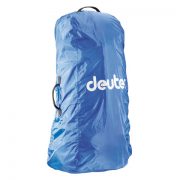
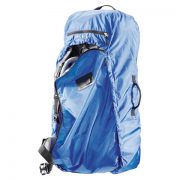
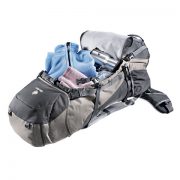
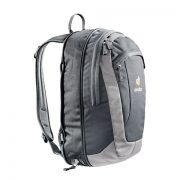
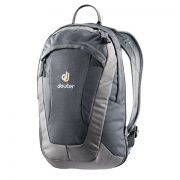
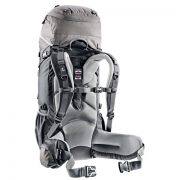
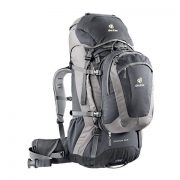
Great review man. Very informative and interesting. I have been researching extensively and have also been closely considering the Waypoint 65 and Quantum 55 + 10. Your experienced assessment of the deuter is very helpful. Muchly appreciated.
Hi Logan. Glad my review was of some value. Do come back and post with your final decision and how satisfied you are in the end.
hi…that was a great review on this pack
actually, i want to buy a pack that can be use on hiking+tavelling.
is it quantum 55+10 suitable for both activities?
or should i just choose deuter futura vario 50+10?
can u help me to decide which one is better….
=D
I am not too familiar with the vario so I can't give much help, but I can say that I did a hike with my Quantum and it was OK but I found it a bit too narrow for carrying some bulkier items (in this case plastic boots for crampons) so that is something to consider.
I’ve used the vario on both hikes as well as travels myself. I don’t have any complaints so far. I’ve never used a quantum, but it looks to me like vario and quantum are on par.
oke..thanx for your replies,
one more, if my height is 170cm and im skinny asian…
which capacity is fit which my body height?
50+10 or 40+10
Again, I am not familiar with the other option, but I can say that Deuter offers adjustable torso lengths, which is what you need to know more than your actual height (a shorter person could have a longer torso than someone taller or vice versa). You absolutely should try both to see which is more comfortable for you.
Having said that, and thinking a bit more, perhaps the Quantum isn't the best choice if you will include hiking. I think a basic top loading pack would probably be better. Also, the material the Quantum is made of is quite strong but that adds some weight. I believe the packs designed primarily for hiking are made with lighter (but still strong) materials.
Which Osprey backpack of a similar size do you think is worth purchasing? Any advice would be great! Also, do you think that a 65L pack for a 9 month trip to south/central america is too large?
Good stuff!
Yes, A man is as old as he feels.
Hey, nice review. There isn't much info on this backpack around so, it's good someone did a complete analysis. One question, does it comply as a carry on? I figured that maybe if u de-attach the top loading thing maybe it could fit as cabin lugagge…
No, it won't qualify as a carry on bag – though I have never tried so maybe if you get an agent that isn't strict… that top loading part cannot really detach, but if you underpack you can sort of squish it down. In that case I think the dimensions would still not qualify, but I am not sure.
Just came across your review. I was looking at the Deuter transport cover which looks interesting as it also doubles as a rain cover. The only thing that has me worried is there seems to be a single zip pouch away from the main compartment that doesn’t look like it’s lockable. Is that right or can you lock it? It seems mad to have a pouch that someone could slip something in when in transport.
I am not currently using my Deuter so I cannot check to confirm, but I do not recall any single zip pouch on the cover. Could be bad memory on my part or possibly something that has been added since I bought mine some years back. OR, are you referring to a single zip pouch on the main pack itself. Because, yes I believe there is one of those, which I mostly used for toiletries, and ready-access items.
Hi JB..Awesome review… Several questions from me.
1. Is it possible to lock the daypack to the main backpack?
2. I’m considering to use the daypack for my laptop..Does it have a safety features? i.e. possible to Lock the zip?
Thanks in advance!!!
Well, I am on the road with a different pack (an Osprey Farpoint) so I can’t look and see. But, going by memory, yes the daypack can be locked (I *believe* the dual zippers interlock making it easy to lock with a regular luggage lock). As for locking the daypack to the main pack, no that cannot be done easily since it gets attached by multiple buckles. Also, the daypack is pretty small so it might not be a great option for a laptop, unless you are talking a very small one. And, there is no padded sleeve, so you would want to at least use a neoprene sleeve for the laptop.
Understand, this is my memory of my pack, which is about 6 years old and which I haven’t used in about 3 years. I imagine that they have made some modifications since then so you really should check in person or with someone who bought one more recently.